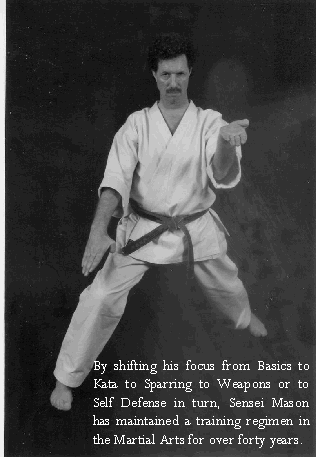
September News
“You are What You Eat”: Nutrition, Sports and Karate
We all have to eat, but what, how much and when we eat affects how we feel, and how we grow. My own nutritional habits are pretty simple. I have finished growing and am mostly interested in giving my body the fuel it needs to allow me to train, and replace and repair itself. I take a blue-green algae pill when I first get up in the morning. I follow that with a spoonful of flax seed oil and a thimble sized portion a of liquid organic mineral supplement and vitamins. On the way to the Dojo I drink a protein shake. If I am working from home I eat a portion of whole grain cereal with soy milk. I train in the morning three days a week, so after class I eat an apple and drink water, followed by a Shaklee performance drink that replenishes minerals. My main meal of the day is usually a six inch vegetarian subway sandwich, followed by a cup of tea, English style at 4:00 pm. If I eat at home later it will be a light snack, like a pocket sandwich or a piece of fruit.
Many times students and their parents are unsure about how to schedule their nutrition while they are in training; should they eat before or after class, how much should they eat and what should they eat? As students return to school and schedules become more regulated it is more important than ever for them to plan ahead so that proper nutrition becomes a habit. A high carbohydrate vegetarian meal is good for endurance...full of nutrient-dense complex carbohydrates which keep the muscles provided with the energy needed for a high intensity workout. Without these vital fuels, athletes become exhausted too quickly …”hitting the wall” according to an article by Kimberly Lord Stewart. Lisa Dorfman, sports nutritionist at the University of Miami, says that “without adequate levels of carbohydrates the body reaches for the next available energy source, fat and protein stores taxing the muscles, kidneys and liver”.
Complex carbohydrates include whole grain pastas, cereals, breads, crackers and rice, legumes, vegetables and fruits. Dorfman recommends a combination of complex and simple carbohydrates, such and granola bars and sports drinks, are good for pre and post training meals. Eating one to four hours prior to exercise helps optimize liver glycogen levels the body’s primary source for energy, says Susie Parker-Simmons, sports dietitian for the United States ski team. Pre-exercise meals could include iron fortified dry cereal with low fat milk, fruit and juice; fruit salad and yogurt or pancakes, and waffles.
Without protein athletes are more likely to lose stamina and energy; adequate protein intake ensures the amino acids necessary for muscle development. I prefer to get my protein from vegetarian sources, but it is important to have all eight essential amino acids at the same time in order to assimilate the protein. For me that means eating whole grain brown rice and beans, or a similar meal that includes grains and legumes. Cheese and dairy products (milk and eggs for example) also contain protein as do meat, poultry and fish. If you are following a particular dietary regimen it is important to thoroughly research the diet in question and assure yourself that it will suit your needs and promote good health, rather than just weight loss.
© Sensei Robert H. Mason 2004
Boost your performance by applying training strategies that elite athletes
use to avoid fitness rutsAccording to MSNBC expert Jacqueline Stenson, if you are doing the same activities week in and out you are bound to eventually hit what fitness experts call a plateau. Essentially your body adapts to the type and frequency of physical activity that you are doing so the exercise is not as challenging as it used to be. You won’t see major declines in your physical fitness and you won’t see improvements either because you are not subjecting your body to enough stimulus for change. Repeatedly working the same body parts in the same way can actually lead to over-training injuries.
How do you avoid hitting a plateau or break free of a rut in you are already in one?
“If your workout is stale, you get frustrated and you develop a negative attitude”, says personal trainer Todd Durkin, a spokesperson for the American Council on Exercise. “Your body needs change.” This means mixing up workout to include a range of activities at different intensities.
Professional athletes stay tuned into what is happening with their performance; they get very good about listening to their bodies, says Dr. Nicholas DiNubile, consultant to the Pennsylvania Ballet. “If something really hurts, don’t do it. If you need rest, take a day off or engage in lighter exercise. If you feel like you are coasting during a workout, you probably need to kick things up a notch if you want to get greater results.”

Other tips for improving your workout from the American Council on Exercise include
getting a workout buddy (to keep you motivated and working hard), focusing on your breathing (take full breaths during each exercise, exhaling on the exertion and inhaling as you release), picking the best time of day to work out (when you have the most energy).For those who have watched the Olympics and get inspired to start an exercise program, remember to take things slowly at first, to avoid injury. According to DiNubile, “exercise is medicine; if you overdose you can get into trouble just as you can if you underdose.”